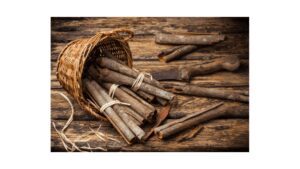Know in one minute about Cinnamomum burmannii
|
Introduction
Cinnamon (Cinnamomum spp., family Lauraceae ) is one of the oldest and most frequently consumed spices worldwide.
It is the brown bark of the cinnamon tree. This bark is when dried rolls into a quill tubular form (cinnamon sticks) and is also available as a ground powder. It not only improves the taste of food but is also good for health due to its functional properties.
There are different species of cinnamon, spread mainly in Asia, China, and Australia.
Types of cinnamon
There are mainly four types of cinnamon which are aromatic and flavoring, being used for commercial purposes.
- Cassia cinnamon or Chinese cinnamon (Cinnamomum aromaticum or Cinnamomum cassia ) the most common type
- Indonesian Cinnamon or Korintje or Padang or Batavia or Java cassia (Cinnamomum burmannii )
- Vietnamese cinnamon or Saigon Cinnamon, Vietnamese cassia (Cinnamomum loureiroi )
- True cinnamon or Pure or Ceylon or Mexican or Sweet cinnamon (Cinnamomum zeylanicum or Cinnamomum verum)
Difference between cinnamons
There are some differences found in these cinnamons. Let’s take a closure look at some of these dissimilarities with different levels of flavor and situations (1).


True cinnamon |
Korintje cinnamon |
Saigon Cinnamon |
Cassia cinnamon |
|
Origin |
Sri Lanka | Indonesia | Vietnam | China |
Flavor |
Mild sweet and light flavor. | Strong Spicy Cinnamon flavor (strong aroma) | Intensely fragrant and flavorful, almost spicy due to
high levels of oil content , |
Spicy and more aromatic but bitter (very strong taste) |
Color |
Light to medium reddish brown | Dark reddish-brown | Reddish-brown dark | Dark reddish-brown |
Use |
Bark, Bark oil, Leaf, Leaf oil | Oil, bark | Bark, Oil | Oil, Bark |
Coumarin content |
Ultra-low coumarin levels | High coumarin levels | Coumarin is high | High coumarin |
Quality |
Better quality | Good quality | Lower quality | inferior quality |
Price |
Expensive and available in the global market | Less expensive than other cinnamon (cassia cinnamon and Ceylon cinnamon) | Less expensive, and easily found | Widely available,
Cheap |
Health benefits of Cinnamomum burmannii
Cinnamomum burmannii is available in three grades such as A, B, and C. In this, C-grade cinnamon is most bitter and astringent. On the other hand, A-grade cinnamon is sweet and mellow. Let’s look at some of these benefits (2).
1. Lower cholesterol level
Cinnamomum burmannii contain a phenolic compound known as cinnamaldehyde. This compound lowers bad cholesterol levels and prevents oxidative stress. It removes cholesterol by eliminating bile and prevents damage to cells (3).
2. Treat fever
Intake of Cinnamomum burmannii helps to reduce fever in less time (first 30 minutes) (4).
3. Keep skin healthy
Ultraviolet rays are the major cause of sunburns. However, Cinnamomum burmannii has the potency to protect against UV-B radiation. The bark of this plant has sunscreen activity with high melanin and SPF value and protects from sunburn (5).
4. Boost immunity
Cinnamomum burmannii contains cinnamaldehyde, which acts as a natural trigger of the body’s immune response. It engulfs and kills invading pathogens, removes foreign particles from the body, and boosts the immune system (6).
5. Antimicrobial properties
Cinnamaldehyde and proanthocyanidins found in Cinnamomum burmannii act as natural food preservatives. It inhibits the growth of food-borne bacteria like Bacillus cereus, Listeria monocytogenes, Escherichia coli, and Salmonella anatum (7).
Moreover, the bark of this cinnamon fights against all Streptococcus spp., treating decayed tooth and periodontitis, and is effective as a mouthwash (8).
6. Treat cancer
Cinnamomum burmannii is rich in phenolic acid that inhibits the growth of cancer cells. It also induces apoptosis to kill cancer cells. It also helps to remove harmful radicals from the body and prevent diseases (9).
7. Anti-inflammatory properties
Cinnamomum burmannii contains flavonoids and alkaloids that enhance the natural antioxidant defense system (10). It also reduces swelling thus protecting the kidney and liver from damage (11).
8. Treat depression
Depression is a psychiatric disorder that results in decreased self-care and even life-threatening action. It is due to the reduction of serotonin in the brain. However, Indonesian cinnamon potentially reduces symptoms of depression by improving serotonin levels in the brain (12).
9. Manage diabetes
Intake of Indonesian cinnamon tea or extract contains phenolic compounds that can significantly lower the insulin serum level. It also improves body weight and food consumption in a diabetic or obese person (13).
Side effect of Indonesian cinnamon
Indonesian cinnamon is well tolerated and shows no toxic effect on the liver, kidney, and blood in animals (14).
Although this cinnamon has many health benefits, most research studies have been conducted on the animal not human. Thus, more evidence is needed to establish its usefulness because no one knows the long-term effect on the human body.
Q&A
1. Cinnamomum burmannii where to buy?
You can get Indonesian cinnamon in grocery stores or supermarkets and also can buy it online.
2. What is Cinnamomum burmannii?
Cinnamomum burmannii is the most common, less expensive, and aromatic spice. It is famous for its stronger and sweetest cinnamon especially found in the area of Sumatra and Java islands.
It is widely used for medicinal purposes and seasoning for many dishes. C. burmannii, although high in cinnamaldehyde, has a smoother taste with less bite than C. cassia and C. loureiroi (15).
3. How much Cinnamomum burmannii do I use to lower my blood sugar?
No recommended dosages are reported for Cinnamomum burmannii. However, intake of a moderate amount of this cinnamon is good for health because no one knows its long-term effect.
Although, Cinnamomum burmannii contains a high amount of cinnamaldehyde but has a smoother taste with less bite than other cinnamon.
